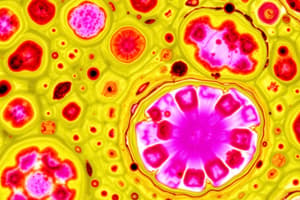Podcast
Questions and Answers
The shape of the external ear is maintained by:
The shape of the external ear is maintained by:
- Nervous tissue
- Elastic cartilage (correct)
- Adipose tissue
- Muscle tissue
Organized groups of cells (plus their intercellular substance) that have a common purpose form a(n):
Organized groups of cells (plus their intercellular substance) that have a common purpose form a(n):
- Organism
- Organ system
- Organ
- Tissue (correct)
Functions of the epithelia include all of the following, except:
Functions of the epithelia include all of the following, except:
- Controlling permeability
- Providing physical protection
- Producing specialized secretion
- Absorption
- Storing energy reserves (correct)
Which of the following membranes line cavities that are open to the environment?
Which of the following membranes line cavities that are open to the environment?
The basic shapes of epithelial cells include all of the following, except:
The basic shapes of epithelial cells include all of the following, except:
Which of these is not considered connective tissue?
Which of these is not considered connective tissue?
Tissue that is specialized for the conduction of electrical impulses is ___________ tissue.
Tissue that is specialized for the conduction of electrical impulses is ___________ tissue.
The three main components of connective tissue are:
The three main components of connective tissue are:
Each of the following is the primary tissue type, except:
Each of the following is the primary tissue type, except:
Tissue that is specialized for contraction is __________ tissue.
Tissue that is specialized for contraction is __________ tissue.
Matrix is:
Matrix is:
___________ epithelium appears to have two or three layers of cells, but all the cells are in contact with the basement membrane.
___________ epithelium appears to have two or three layers of cells, but all the cells are in contact with the basement membrane.
The fiber type that gives connective tissue great tensile strength is:
The fiber type that gives connective tissue great tensile strength is:
Dead skin cells are shed in thick sheets because they are held together by a thin layer of proteoglycan reinforced by intermediate filaments. Such strong intercellular connections are:
Dead skin cells are shed in thick sheets because they are held together by a thin layer of proteoglycan reinforced by intermediate filaments. Such strong intercellular connections are:
Which statement best describes connective tissue?
Which statement best describes connective tissue?
A transitional epithelium would be found:
A transitional epithelium would be found:
The muscle tissue that shows no striations is __________ muscle.
The muscle tissue that shows no striations is __________ muscle.
Select the correct statement regarding adipose tissue.
Select the correct statement regarding adipose tissue.
Epithelial tissue:
Epithelial tissue:
The first step in tissue repair involves:
The first step in tissue repair involves:
The red color and heat associated with inflamed tissue is the result of:
The red color and heat associated with inflamed tissue is the result of:
Select the correct statement regarding epithelia.
Select the correct statement regarding epithelia.
Simple cuboidal epithelia are usually associated with secretion and absorption.
Simple cuboidal epithelia are usually associated with secretion and absorption.
Squamous cells are flattened and scalelike when mature.
Squamous cells are flattened and scalelike when mature.
Depending on the functional state of the bladder, transitional epithelium may resemble stratified squamous or stratified cuboidal epithelium.
Depending on the functional state of the bladder, transitional epithelium may resemble stratified squamous or stratified cuboidal epithelium.
Smooth muscle cells possess central nuclei but lack striations.
Smooth muscle cells possess central nuclei but lack striations.
Epithelial tissue always exhibits polarity; that is, they have a free surface and a basal surface.
Epithelial tissue always exhibits polarity; that is, they have a free surface and a basal surface.
Most connective tissue have regenerative capacity, while most epithelial tissue do not.
Most connective tissue have regenerative capacity, while most epithelial tissue do not.
Flashcards are hidden until you start studying
Study Notes
Tissue Types and Structures
- The external ear shape is supported by elastic cartilage.
- Organized cellular groups with a common function are called tissues.
- Epithelial tissue functions include controlling permeability, protection, and absorption, but not energy storage.
- Mucous membranes line cavities that open to the environment.
- Basic epithelial cell shapes include columnar, cuboidal, and squamous; stratified is not a shape but a layering.
- Muscle tissue is not classified as connective tissue.
Connective Tissue Characteristics
- Nervous tissue conducts electrical impulses.
- Connective tissue comprises ground substance, fibers, and cells; matrix refers to fibers and ground substance.
- Collagen fibers provide tensile strength to connective tissue.
Types of Epithelia
- Pseudostratified columnar epithelium has cells touching the basement membrane, creating an appearance of multiple layers.
- Transitional epithelium lines the urinary bladder, allowing for stretching.
- Simple cuboidal epithelium is associated with secretion and absorption.
Muscle Tissue
- Smooth muscle tissue lacks striations and is involuntary.
- Striations are present in skeletal and cardiac muscle tissues.
Tissue Repair and Inflammation
- The initial step in tissue repair involves the formation of granulation tissue.
- Redness and heat in inflamed tissue result from local vasodilation (blood vessel dilation).
Epithelial Characteristics
- Stratified epithelia protect against abrasion, while simple epithelia often do not provide impermeable barriers.
- Epithelial tissue has a basement membrane and exhibits polarity, featuring a free surface and a basal surface.
Miscellaneous Facts
- Smooth muscle cells contain central nuclei but lack striations.
- Most connective tissues possess regenerative capacity, while most epithelial tissues do not.
Studying That Suits You
Use AI to generate personalized quizzes and flashcards to suit your learning preferences.




